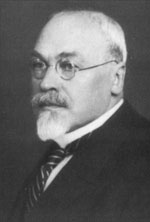Gustavs Zemgals facts for kids
Quick facts for kids
Gustavs Zemgals
|
|
|---|---|

Zemgals in 1927
|
|
| 2nd President of Latvia | |
| In office 8 April 1927 – 9 April 1930 |
|
| Prime Minister | Marģers Skujenieks Pēteris Juraševskis Hugo Celmiņš |
| Preceded by | Pauls Kalniņš (Acting) |
| Succeeded by | Alberts Kviesis |
| Personal details | |
| Born | 12 August 1871 Džūkste parish, Courland Governorate, Russian Empire (now Tukums Municipality, Latvia) |
| Died | 6 January 1939 (aged 67) Riga, Latvia |
| Political party | Democratic Centre (1922–1934) |
| Spouse | Emīlija Zemgals |
| Children | 2 |
| Awards | Order of the Three Stars Legion of Honor, Commander Class |
Gustavs Zemgals (born August 12, 1871 – died January 6, 1939) was an important Latvian politician. He was the second President of Latvia. He also served as the mayor of Riga city two times.
Contents
Gustavs Zemgals: Early Life and Education
Gustavs Zemgals was born in Džūkste, Latvia. He went to elementary school in a small area called Saka. Later, he continued his studies at Riga Nikolai Gymnasium. In 1899, he finished his law studies at Moscow University. After that, he came back to Latvia. He worked as a lawyer, edited newspapers, and was active in politics.
Military Service and Journalism
In 1904, the Russo-Japanese War began. Zemgals was called to serve in the army. He spent about a year and a half at the front lines. He was promoted to the rank of captain.
After returning to Latvia in 1905, Zemgals helped start a new liberal newspaper. It was called "Jaunā Dienas Lapa" (New Day's Page). He became the editor of this paper. He also edited the next newspaper, "Mūsu Laiki" (Our Times). In 1907, a court in Riga sentenced Zemgals to three months in jail for his work at "Mūsu Laiki". Soon after, Zemgals and other political activists created the Latvian democratic party. From 1912 to 1914, Zemgals also worked on a magazine called "Domas" (Thoughts).
Political Career and Latvia's Independence
When World War I started, Zemgals was called to serve in the army again. He was first sent to an infantry division in central Latvia. Later, he was moved to Finland. After he returned to Riga, he was chosen as the city's chairman on April 23, 1917. In the autumn of 1917, the Riga Temporary Council chose Zemgals as chairman again. At this time, he was very active in the Latvian radical-democratic party.
Role in Founding Latvia
From 1918, Zemgals became active in the Latvian Provisional National Council. Here, he worked on issues for Latvian areas that were under occupation. As a member of the Latvian radical-democratic party, he became the second deputy chairman of the Tautas Padome (People's Council). This council was a group of Latvian political parties and organizations. In this role, he led the meeting on November 18, 1918. At this meeting, the independence of Latvia was declared. On December 3, 1918, he was chosen as the chairman of the Riga City Council.
When the bolsheviks were gaining power and moving towards Latvia, the Tautas Padome sent Jānis Čakste and Zemgals abroad. Their job was to represent Latvia's interests. Čakste, Zemgals, and others from the government traveled to Copenhagen on a British warship. However, Zemgals returned to Latvia just two months later. He tried to bring the Tautas Padome back together. But Zemgals and a group of loyal politicians were arrested by the German army.
Presidency of Latvia
Later, Gustavs Zemgals became a member of the Latvian parliament (Saeima). He was part of the Democratic Centre party. He also served as a minister in several governments. In 1927, after the death of the first president, Jānis Čakste, Zemgals was elected the president of Latvia.
Presidential Actions and Legacy
As president, Zemgals did not often interfere with the Saeima's work on laws. He only sent one law back to the Saeima for review. However, Zemgals often used his right to grant amnesty. Amnesty means officially forgiving someone for a crime. During his time as president, Zemgals granted amnesty to 648 people. Out of these, 172 people received complete forgiveness. He served as president until 1930, when his term ended. He chose not to run for a second term, even though many people asked him to.
After his presidency, Zemgals continued his political work. He was elected to the fourth Saeima. There, he was a member of important committees. These included foreign affairs, finance, trade, and industry. From 1931 to 1932, he also served as the Minister of Finance.
Awards and Later Life
In 1924, the French government gave Zemgals the Legion of Honour. This is France's highest award. He received the Commander cross. In 1926, he was given the Order of the Three Stars. This is Latvia's highest national award. He received the Third class, also known as "Commander." In 1929, he received the highest level of the Three Star Order. This was the First class with chain. Only 14 people received this special award before World War II.
During the 1930s, Zemgals wrote articles for the newspaper "Jaunākās Ziņas" (Latest News).
Gustavs Zemgals passed away on January 6, 1939. He was buried in Riga. In 1990, a monument to Zemgals was built in Džūkste, the place where he was born.


